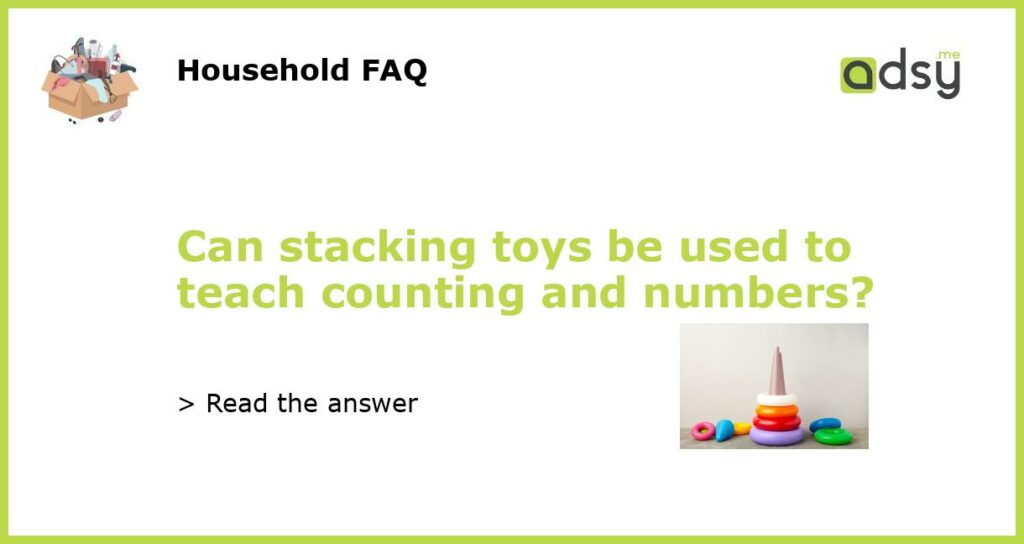Yes, stacking toys can be used to teach counting and numbers
Stacking toys are not only fun and entertaining for children, but they can also be a valuable tool for teaching counting and numbers. These toys can help children develop their mathematical skills in a hands-on and interactive way. By using stacking toys, children can practice counting, recognize numbers, learn the concept of quantity, and even begin to understand basic addition and subtraction. Let’s explore how stacking toys can be used to teach counting and numbers.
Introducing Counting Through Stacking
One of the simplest and most effective ways to use stacking toys for teaching counting is to encourage children to count each piece as they stack them. Whether it’s stacking rings, blocks, or cups, each time a child adds a new piece to the tower, they can say the number out loud. This helps them associate the physical act of stacking with the numerical value.
For example, if a child is stacking rings, they can say “one” as they put the first ring on the stack, “two” for the second ring, and so on. This repetition helps reinforce their understanding of numbers and counting, while also improving their hand-eye coordination and fine motor skills.
Recognizing Numbers and Quantity
Another way stacking toys can teach counting and numbers is by helping children recognize and associate numerical symbols with quantity. Many stacking toys come with numbered pieces or stickers on each piece, which allows the child to visually connect the number with the corresponding quantity of objects being stacked.
For example, if a set of stacking cups has numbers 1 to 5 on each cup, the child can practice matching the number with the correct quantity of cups. This activity helps them understand that the symbol “2” represents two cups, “3” represents three cups, and so on. Over time, this helps them develop a foundational understanding of numerical symbols and their meaning.
Basic Addition and Subtraction
In addition to counting and number recognition, stacking toys can also be used to introduce basic addition and subtraction concepts to young children. By manipulating the pieces and physically adding or removing them from the stack, children can begin to understand the concept of adding to and taking away from a set.
For example, if a child has a set of stacking blocks and they want to add two blocks, they can start with a stack of three blocks and add two more. They can practice saying “three plus two equals five” as they physically add the blocks. Similarly, they can practice subtraction by removing blocks from the stack and saying “five minus two equals three.”
This hands-on approach to addition and subtraction helps children visualize and internalize these mathematical operations, making them more concrete and meaningful.
Building Spatial Reasoning and Problem-Solving Skills
Aside from teaching counting and numbers, stacking toys also contribute to the development of spatial reasoning and problem-solving skills. As children stack and balance the pieces, they must use their spatial awareness to ensure the tower remains stable. This requires them to think about how the sizes and shapes of the pieces fit together.
Through trial and error, children learn to problem-solve as they figure out the best strategies for building tall and sturdy towers. They develop an understanding of cause and effect, as they realize that if they stack the pieces in a certain way, the tower may topple over.
Fun and Engaging Learning Experience
One of the major advantages of using stacking toys to teach counting and numbers is that it creates a fun and engaging learning experience for children. Rather than using traditional worksheets or flashcards, stacking toys allow children to learn through play, which is often more enjoyable and memorable for them.
The hands-on nature of stacking toys encourages active participation and stimulates multiple senses, making the learning process more interactive and effective. Children can experiment, explore, and make connections between the physical act of stacking and the abstract concept of counting and numbers.
In conclusion, stacking toys can be a valuable educational tool for teaching counting and numbers to young children. Whether it’s through counting each piece as they stack, recognizing numbers and quantity, exploring addition and subtraction, developing spatial reasoning, or enjoying a fun learning experience, stacking toys provide a variety of benefits for children’s mathematical development. So the next time you see a stack of toys, remember that they can be much more than just a playtime activity – they can be a doorway to mathematical understanding.






